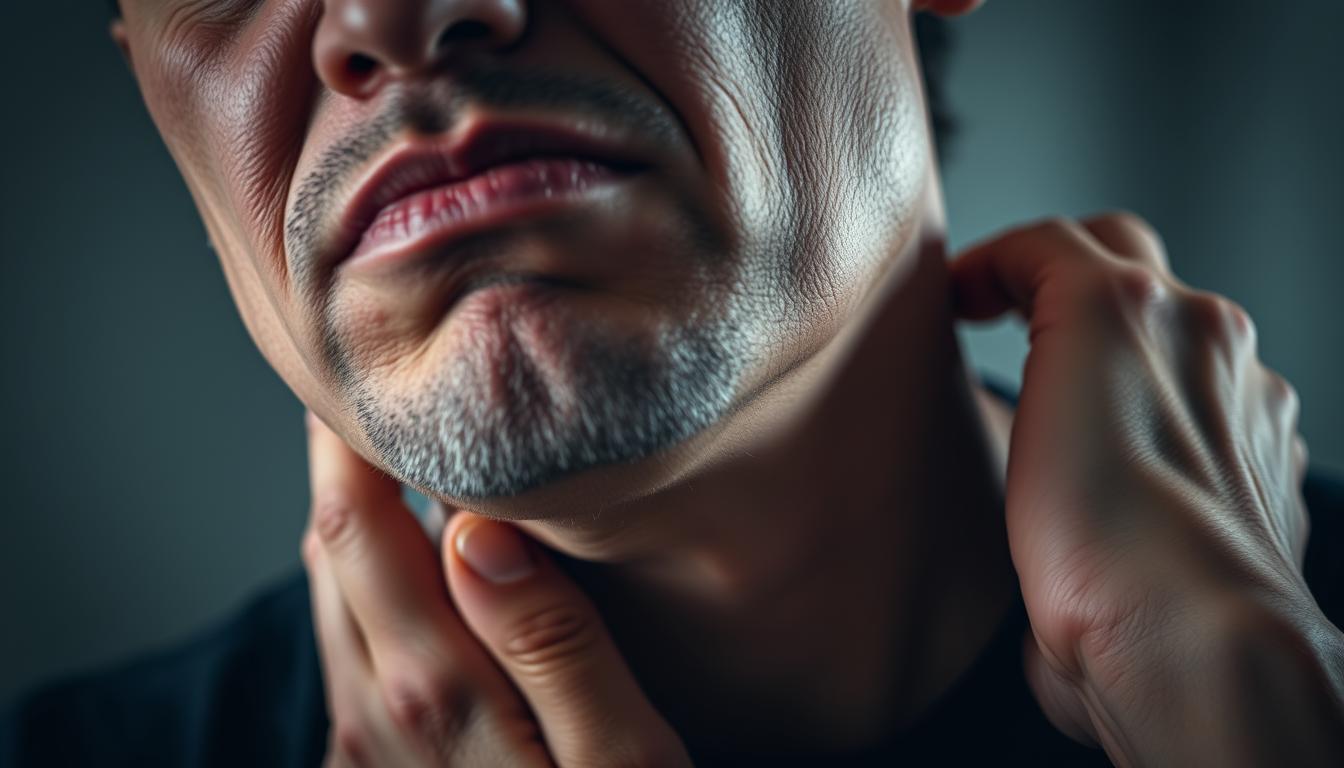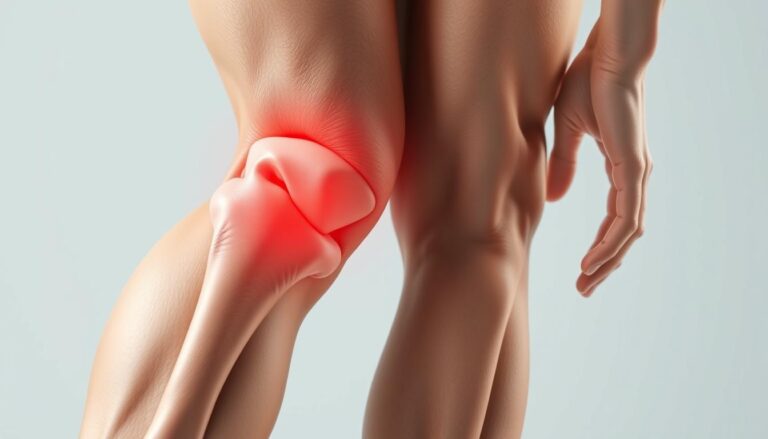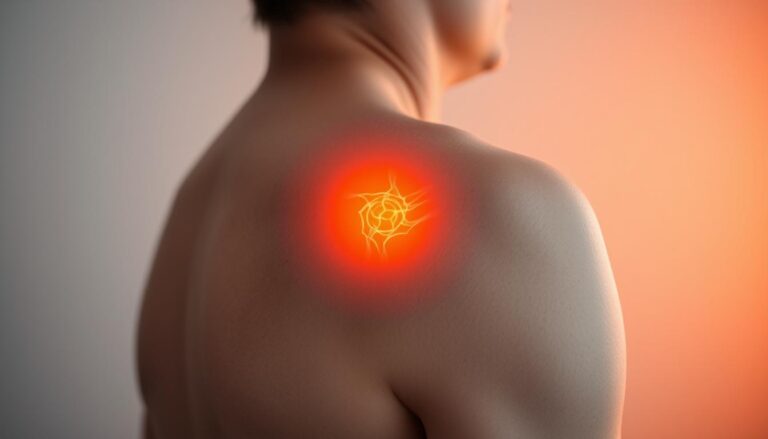Sore Neck and Ear Pain on One Side: Causes & Relief
In clinics and urgent-care centers across the United States, a sharp tug at the base of the skull is a common complaint. This sensation travels into the ear. One-sided neck and ear pain can stem from various sources. These include a strained sternocleidomastoid muscle, a middle ear infection, or pressure on a cervical nerve from degenerative disc disease.
Most cases are not life-threatening. However, the combination of neck stiffness, jaw clicking, and ear discomfort often prompts people to seek quick relief. They look for neck pain relief and ear pain treatment.
Chronic cervical spine problems like cervical spondylosis may be incurable. Yet, they are manageable with targeted care. Short-term fixes include over-the-counter NSAIDs or acetaminophen, along with heat or ice. Physical therapy—especially isometric and resistance exercises—builds neck and upper-back strength.
It also reduces recurrence. For ear issues, otitis media sometimes clears without antibiotics. On the other hand, otitis externa usually responds to medicated ear drops.
Key Takeaways
- One-sided neck and ear pain can stem from muscles, joints, nerves, or ear infections.
- Simple measures—NSAIDs, heat/ice, and posture fixes—often provide immediate neck pain relief.
- Ear pain treatment varies: drops for swimmer’s ear, selective antibiotics for middle ear infections.
- Persistent or severe signs—fever, marked stiffness, or neurological changes—need prompt medical review.
- Physical therapy and ergonomic changes are mainstays for long-term management of cervical causes.
Understanding the Relationship Between Neck and Ear Pain
The neck and ear are in close proximity, making it common for pain in one area to be felt in the other. Healthcare professionals analyze patterns and triggers to identify the source of neck and ear pain. They use symptom mapping to determine if the issue stems from muscle strain, an ear infection, or nerve irritation.
How Neck Structures Can Refer Pain To The Ear
Cervical spine issues often lead to referred pain. Problems like degenerative discs or spondylosis can irritate nerve roots. This irritation sends pain signals to nearby areas, including the ear.
Tight neck muscles and trigger points can also cause pain to radiate upward. This sensation can mimic the symptoms of ear disease.
Key Nerves And Muscles Involved
The sternocleidomastoid muscle connects the ear to the collarbone. Trigger points in this muscle can cause pain in the ear, eye, or sinuses. Cervical nerves, emerging from the spine, carry sensory signals that may be felt as ear discomfort when compressed.
The trigeminal nerve connects facial, dental, and sinus pathways with ear sensation. Dental infections, sinus inflammation, or TMJ strain can cause pain on the same side of the neck and ear.
Common Patterns Of One-Sided Pain And Why It Matters
One-sided neck and ear pain often follows a predictable pattern. Muscle-origin pain causes localized tenderness and tightness with specific trigger points. Otitis media or externa presents with visible otoscopic findings and ear-specific symptoms.
Neuropathic or radicular pain brings radiating numbness, tingling, or weakness down the arm. Identifying these patterns helps narrow down the likely causes. This guides targeted treatment, whether it’s physical therapy for the neck, dental evaluation, or ENT assessment.
Common Causes Of One-Sided Neck And Ear Discomfort
One-sided neck and ear pain can stem from various sources. Muscle issues near the ear, internal ear problems, or issues with the jaw and spine are common culprits. Understanding these causes aids in selecting appropriate treatments and home remedies.
Muscle strain and myofascial pain syndrome are frequent causes. Trigger points, small muscle knots, can cause pain in the ear. These knots often form in muscles like the sternocleidomastoid.
Over-the-counter pain medication, heat or ice packs, and specific stretches can help with muscle pain. Physical therapy and improving posture can prevent future episodes. Some turn to chiropractic care when simpler remedies fail.
Ear infections are another common source of pain. Otitis media, an infection behind the eardrum, may require antibiotics. Otitis externa, an infection in the ear canal, is treated with medicated ear drops.
Both types of ear infections can cause neck pain. Home remedies include warm compresses, gentle neck movements, and staying hydrated. It’s important to watch for fever or worsening symptoms.
Temporomandibular joint dysfunction affects the jaw and can cause neck and ear pain. Clenching teeth, stress, and uneven bites can irritate the joint, leading to pain on one side.
Short-term use of NSAIDs, jaw stretches, stress reduction, and night guards can help manage TMD. A dental check-up is crucial if jaw alignment or chronic clenching seems to be the cause.
Cervical spine issues include degenerative disc disease, cervical spondylosis, and nerve root compression. These can cause pain that radiates to the ear.
For spine-related pain, initial treatment includes rest, NSAIDs, and physical therapy. Severe or worsening symptoms may require imaging and surgery.
When the cause is unclear, healthcare providers consider muscle, ear, jaw, and spine issues. They recommend targeted treatments based on the most likely diagnosis.
Red Flags And When One-Sided Neck And Ear Pain Needs Urgent Care
One-sided neck and ear pain can be routine or a sign of something serious. A short checklist helps separate urgent complaints from those suited to primary care. Watch for sudden changes, rapid worsening, or systemic signs that suggest infection or neurologic problems.
Signs Suggestive Of Meningitis
Neck stiffness paired with high fever and a severe headache is a classic warning cluster. About seven in ten adults with bacterial meningitis show neck stiffness. When these neck and ear pain symptoms appear alongside fever and an intense headache, prompt emergency evaluation is necessary to rule out meningitis.
Neurological Warning Signs
Severe drowsiness, sudden weakness on one side of the body, new confusion, trouble speaking, or seizures are all red flags. These findings point to central nervous system involvement. Rapid triage and imaging can be lifesaving when neurological signs accompany neck and ear pain.
When Progressive Hearing Loss Or Drainage Requires Immediate Evaluation
Worsening fever, new ear drainage, or progressive hearing loss suggest a spreading infection such as complicated otitis or mastoiditis. These conditions can damage hearing or extend into nearby structures. Urgent ENT or emergency assessment is appropriate when drainage or hearing decline appear with escalating symptoms.
Most cases of ear pain remain benign, yet clinicians stay alert for the small number that become severe. For practical neck and ear pain management, contact a clinician or use telehealth triage when red flags show up. Early evaluation reduces the chance of complications and guides timely treatment.
Sore Neck And Ear Pain On One Side
When pain settles on one side of the neck and extends to the ear, it often reveals a specific cause. The location of tenderness, whether chewing is painful, and the duration of symptoms are key indicators. These factors guide the selection of treatments for neck and ear pain.
Typical Symptom Clusters With This Exact Presentation
Muscle-related discomfort typically presents as localized tenderness, tightness, and pain that intensifies with head movement. Trigger points in the sternocleidomastoid (SCM) muscle can radiate pain to the ear, eye, and sinus areas.
TMD symptoms include jaw clicking, difficulty chewing, and morning tooth-grinding. Ear infections manifest as fullness, muffled hearing, or visible drainage. Radiculopathy, on the other hand, causes sharp, shooting pain accompanied by numbness or weakness in the arm.
How Duration And Accompanying Symptoms Help Narrow Diagnosis
Pain lasting a few days to two weeks after a cold or minor strain often resolves on its own. Viral causes typically resolve within this timeframe. However, acute bacterial ear infections may persist longer and require specific treatment.
Chronic stiffness or recurrent pain episodes suggest degenerative changes or ongoing myofascial syndrome. New neurological symptoms, progressive hearing loss, or persistent drainage necessitate immediate evaluation.
When To Seek Primary Care Versus Emergency Services
Most cases require a visit to primary care or a referral to specialists like ENT, dentistry, or orthopedics. Consult a healthcare provider if pain persists for several days, mobility is compromised, or hearing deteriorates despite initial home treatments.
Seek emergency services for high fever with stiff neck, severe drowsiness, vomiting, seizures, sudden focal weakness, or rapidly deteriorating mental status. These symptoms indicate a serious infection or neurologic emergency, requiring immediate attention.
Diagnosis: How Clinicians Evaluate One-Sided Neck And Ear Pain
When someone reports one-sided neck and ear pain, clinicians start with a focused visit. They look at the timeline, triggers, and symptoms. This helps them differentiate between possible causes and urgent issues needing quick tests.
History And Physical Exam Pointers
They ask about the onset, fever, hearing changes, jaw symptoms, and past spine issues. These questions help distinguish between musculoskeletal pain and more serious conditions. Checking the sternocleidomastoid muscle can reveal pain points that refer to the ear.
They also examine the TMJ for bite issues, opening problems, and tenderness. Otoscopy is used to inspect the ear canal and eardrum for signs of infection. The cervical spine is assessed for any abnormalities in movement or tenderness.
Basic neurologic tests are done to check for nerve problems. This includes muscle strength, reflexes, and sensory tests.
Common Tests And Imaging
Otoscopy is the first step to confirm ear infections. Neck X-rays can reveal alignment issues and degenerative changes. CT and MRI scans are used when there’s a suspicion of disc problems or infections.
Nerve conduction studies and electromyography are used if neuropathy or persistent pain is suspected. Clinicians aim to use targeted testing to avoid unnecessary radiation and costs. This approach helps catch the structural causes of one-sided neck and ear pain.
Laboratory Tests And When To Culture Or Start Empiric Antibiotics
Blood tests like CBC or CRP are ordered when there’s a concern of systemic infection. Culturing ear discharge helps guide antibiotic treatment for severe infections. Empiric antibiotics are used for patients showing clear signs of bacterial infection or at high risk for complications.
Lumbar puncture is necessary if meningitis is suspected. This is due to symptoms like neck stiffness, fever, and neurologic changes. Clinicians follow a stepwise approach to ensure accurate diagnosis without overtesting.
Evidence-Based Treatments For Neck And Ear Pain
Managing one-sided neck and ear pain requires identifying the cause. Short-term solutions aim to quickly alleviate symptoms. Meanwhile, targeted therapies aim to solve the underlying issue. If conservative care fails or if signs suggest infection, structural disease, or dental issues, specialists are consulted.
Short-Term Relief: NSAIDs, Acetaminophen, Heat And Ice Therapy
For immediate relief, over-the-counter NSAIDs like ibuprofen or naproxen, and acetaminophen, can help. They reduce discomfort and inflammation. It’s important to use the lowest effective dose for the shortest time needed.
Local treatments also offer relief. A warm pack can relax tight neck muscles, while a cold pack can reduce swelling. Alternating between heat and ice can ease muscle spasms and improve comfort in the first few days.
Targeted Treatments: Antibiotics For Bacterial Ear Infections, Ear Drops For Otitis Externa
Antibiotics are often prescribed for bacterial otitis media, especially in high-risk patients or severe cases. Clinicians weigh risks before prescribing, as many middle ear problems may improve with watchful waiting.
Otitis externa typically responds well to topical ear drops containing antiseptics or antibiotics with a steroid. Proper ear canal cleaning by a healthcare professional can speed recovery and reduce the need for systemic medication.
Specialist Interventions: Physical Therapy For Cervical Spine And SCM, Dental/TMJ Care, ENT Referral
Persistent or structural neck pain benefits from physical therapy focused on the cervical spine and SCM muscle release. Isometric and resistance exercises strengthen the neck muscles, reducing recurrence.
Jaw-related pain often needs dental evaluation. Short-term NSAIDs and home stretches help. For chronic cases, night guards, targeted physical therapy, or referral to oral and maxillofacial specialists are considered.
When ear symptoms suggest complicated infection, hearing loss, or persistent drainage, ENT referral is appropriate. Orthopedics or neurosurgery may evaluate severe radiculopathy or structural cervical disease after conservative care fails.
| Treatment Goal | Typical Options | When To See A Specialist |
|---|---|---|
| Immediate Symptom Control | Ibuprofen, acetaminophen, heat/ice, rest | Severe pain not eased by OTC meds or worsening neurologic signs |
| Infectious Ear Pain | Watchful waiting for mild otitis media, oral antibiotics when bacterial, topical drops for otitis externa | Recurrent infections, hearing loss, persistent drainage |
| Musculoskeletal Neck Pain | Physical therapy, SCM trigger point work, posture training, isometric exercises | Failure of conservative care, suspected disc or nerve root compression |
| Jaw-Related Referral Pain | NSAIDs, jaw stretches, occlusal appliances, dental/physical therapy | Persistent TMD symptoms, bite problems, or need for oral surgery |
Clinical decisions balance symptom severity, likely diagnosis, and patient preference. Combining short-term relief with targeted treatments offers a practical path for most patients.
Self-Care, Home Remedies, And Neck Pain Relief Strategies
Small steps at home can make a big difference when you’re dealing with sore neck and ear pain. Simple fixes like adjusting your posture, doing targeted stretches, and using heat or cold can help. They aim to ease pain without causing more irritation.
Posture Correction And Ergonomic Adjustments To Prevent Recurrence
Sit with your ears over your shoulders and your shoulders over your hips. Make sure your monitor is at eye level. Use a chair with lumbar support or add a cushion for better back alignment.
Swap soft pillows for a firmer one, especially if you wake up with neck pain. This can help support your neck better. When driving or reading, avoid tilting your head for long periods. Take short breaks to stretch every 30–45 minutes.
These changes reduce strain on the sternocleidomastoid muscle and help prevent pain from reaching your ear.
Stretching, Isometric And Resistance Exercises For Neck And Upper Back
Start with gentle stretches like chin tucks, side bends, and rotations. Hold each stretch for 15–20 seconds. Then, do isometric exercises by pressing your palm to your forehead and resisting for 5–10 seconds in each direction.
Gradually add light resistance exercises with a Theraband or small hand weights under a physical therapist’s guidance. Strengthening the upper back and deep neck flexors can provide lasting relief. For jaw-related pain, include jaw stretches and soft-clench exercises to ease TMJ strain.
Heat, Cold, Hydration, And Over-The-Counter Options For Acute Flare-Ups
Use a warm compress or heating pad for 15–20 minutes to relax tight muscles. For sharp, recent injuries or swollen areas, apply an ice pack wrapped in cloth for 10–15 minutes to reduce inflammation. Alternate between heat and cold as symptoms change in the first 48–72 hours.
Stay hydrated to prevent muscle cramping. Drink water and consider sports drinks after heavy sweating. For short-term relief, use over-the-counter ibuprofen or acetaminophen as directed. Topical analgesics and trigger-point massage can help with myofascial knots that refer to the ear.
Warm compresses near the outer ear can offer comfort for mild ear pain. Avoid inserting objects into the ear canal. Seek medical evaluation if you have drainage, worsening hearing, fever, or persistent pain despite trying home remedies.
Practical Daily Routine
- Morning: gentle neck mobility and chin tucks for 5–10 minutes.
- Workday: ergonomic monitor position, hourly mini-breaks, and a supportive chair.
- Evening: heat to relax tight muscles, light stretches, hydration, and jaw relaxation exercises if needed.
- Short-term meds: use NSAIDs or acetaminophen as needed; stop if no benefit after a few days and consult a clinician.
This routine forms a balanced home-care plan for neck pain relief and prevention. If pain worsens or lasts more than a week, seek clinical assessment for targeted treatments or specialist care.
Long-Term Management And Preventing Recurrence Of Neck And Ear Pain
Managing chronic neck and ear pain requires a comprehensive strategy. This includes therapy, daily habits, and targeted interventions. A consistent approach helps prevent flare-ups and ensures lasting relief from neck pain, avoiding the need for quick fixes.
Physical Therapy And Exercise Programs For Chronic Cervical Conditions
Physical therapy focuses on strengthening, improving posture, and enhancing controlled movement. Programs at reputable clinics like Mayo Clinic or Johns Hopkins employ isometric holds, resistance bands, and graded mobility. These methods aim to rebuild endurance.
Regular therapy sessions reduce spasms and enhance function. A tailored home routine ensures continuous progress, supporting long-term management of neck and ear pain.
Lifestyle Changes: Stress Management, Sleep Position, And Avoiding Teeth Clenching
Small changes can make a big difference. Using ergonomic desks, switching to a supportive pillow, and sleeping on the back or side with the neck in a neutral position can significantly reduce strain. These adjustments target the root causes of neck pain.
Stress exacerbates muscle tension and teeth grinding. Techniques like guided breathing, cognitive-behavioral strategies, or apps like Headspace can help manage stress. For persistent clenching, a dental assessment and custom night guard can prevent jaw-driven pain.
When To Consider Advanced Options (Injections, Night Guards, Or Surgery For Severe Structural Disease)
Most people see improvement with conservative treatments. However, if symptoms persist, worsen, or imaging reveals severe degeneration, more aggressive measures may be necessary. This could include steroid injections or referral to a spine surgeon at centers like Cleveland Clinic.
For recurring ear issues, an ENT evaluation may recommend tympanostomy tubes or preventive measures for swimmers to avoid otitis externa. It’s crucial to discuss the risks and benefits with specialists before opting for invasive procedures.
- Referral to physical therapy, dentistry, or ENT ensures coordinated care.
- Routine maintenance—exercise, sleep habits, and ear care—supports neck and ear pain prevention.
- Escalation to injections or surgery is for clearly defined structural disease after conservative trials.
Combining therapeutic exercise, lifestyle adjustments, and timely specialty care builds resilience against recurrence. This approach ensures steady neck pain relief over the long term.
Complications Of Untreated One-Sided Neck And Ear Pain And How To Avoid Them
Ignoring one-sided neck and ear pain can escalate from a minor annoyance to a chronic issue. Initial muscle strain may evolve, while hidden infections or cervical problems can quietly escalate. Prompt intervention prevents small issues from becoming major threats, simplifying pain management.
Risks Of Untreated Infections
Ear and throat infections often start with common symptoms. Untreated bacterial middle ear infections can cause temporary or permanent hearing loss. Infections can spread to the mastoid bone or deeper into the neck or chest.
Early treatment with antibiotics for bacterial infections and prompt referral to an ENT specialist can mitigate these risks. This approach helps prevent hearing damage and invasive infections.
Chronic Pain Consequences
Recurring muscle tension in the sternocleidomastoid and upper trapezius can lead to persistent myofascial trigger points. These trigger points fuel recurring headaches, limited neck motion, and persistent pain that affects daily activities.
Over time, reduced mobility becomes a habit. Physical therapy and targeted home exercises can help break this cycle. Effective management combines hands-on care with simple exercises to restore mobility and alleviate pain.
Importance Of Timely Diagnosis To Prevent Escalation
Severe conditions can disguise themselves as routine pain. Untreated degenerative disc disease can progress to disc herniation with nerve compression. Chronic temporomandibular joint dysfunction can lead to persistent pain, chewing difficulties, and episodes of locked jaw.
Meningitis, though rare, poses significant risks. Delayed diagnosis increases the risk of brain injury, seizures, or worse. Anyone experiencing fever, stiff neck, severe headache, or rapidly worsening symptoms needs immediate evaluation to rule out life-threatening causes.
- Seek primary care when pain persists beyond a few days or worsens despite self-care.
- Choose urgent care or emergency services for fever, neurological signs, or sudden hearing loss.
- Use physical therapy, dental evaluation, or ENT referral as part of long-term neck and ear pain management.
Monitoring symptom patterns and acting early can prevent severe complications of neck and ear pain. A simple examination and appropriate treatment plan often prevent months of discomfort and maintain daily life without constant pain.
Conclusion
Sore neck and ear pain on one side can stem from various sources. These include muscle strain, referred jaw pain, simple ear infections, or cervical spine issues. Many find quick relief with over-the-counter pain relievers, heat or ice, and gentle stretches. Targeted physical therapy and posture adjustments can also help manage neck and ear pain effectively.
However, infections and some structural problems require immediate medical attention. For some middle ear infections, observation might be sufficient. Yet, others may need antibiotics, an ENT referral, or dental treatment. It’s crucial to differentiate between benign causes and serious conditions like meningitis or severe radiculopathy that require urgent care.
Most ear pain is not a cause for concern, but proper care is essential. Combining simple home remedies with professional evaluation is the best approach. If symptoms persist, worsen, or are accompanied by fever or weakness, it’s important to seek medical advice promptly.
FAQ
What Common Conditions Cause Sore Neck And Ear Pain On One Side?
Neck and ear pain on one side often results from muscle or bone issues. Problems like sternocleidomastoid (SCM) strain, myofascial trigger points, or cervical spine issues are common. These include degenerative disc disease, cervical spondylosis, and radiculopathy.
Ear infections, such as otitis media and otitis externa, also cause pain. Temporomandibular joint dysfunction (TMD) and dental or sinus problems can refer pain to the ear. Though rare, serious infections or neurologic problems can also present with this symptom.
How Can I Tell If The Pain Is Muscle-Related Versus An Ear Infection Or Nerve Problem?
Muscle pain usually feels stiff and tender, worsens with movement, and can refer pain to the ear and jaw. Ear infections, on the other hand, cause fullness, hearing changes, or visible drainage. They may also come with fever.
Cervical radiculopathy often brings numbness, pins-and-needles, or weakness in the arm. The duration and symptoms, like fever or hearing loss, help doctors determine the cause.
What Immediate Steps Provide Neck Pain Relief And Help With Ear Pain Treatment At Home?
For quick relief, try over-the-counter NSAIDs or acetaminophen. Applying heat or ice to the sore neck can also help. Gentle stretching and correcting posture can reduce pain.
Stay hydrated and avoid jaw clenching to prevent referred pain. For ear pain, warm compresses are beneficial. Avoid inserting objects in the ear. If you have outer-ear pain, dry the ear after swimming and use topical ear drops as directed.
When Should One-Sided Neck And Ear Pain Prompt Urgent Medical Care?
Seek urgent care if you have a stiff neck, high fever, or severe headache. This could be a sign of meningitis. Also, look for sudden drowsiness, seizures, focal weakness, uncontrolled vomiting, rapidly worsening fever, or progressive hearing loss.
These symptoms indicate serious infection, neurologic emergencies, or spreading ear disease. Immediate evaluation is crucial.
What Long-Term Strategies Prevent Recurrence And When Are Specialists Needed?
For long-term management, focus on physical therapy to strengthen the neck and upper back. Correct your posture and ergonomic setup. Stress reduction and jaw exercises can help with TMD.
Regular follow-ups with an ENT specialist are important for treating recurrent ear infections. Specialists like ENT, dentist/oral-maxillofacial, orthopedic spine, or neurologist are needed for persistent pain, recurrent infections, or progressive neurologic signs. In severe cases, injections, night guards, or surgery might be necessary.




